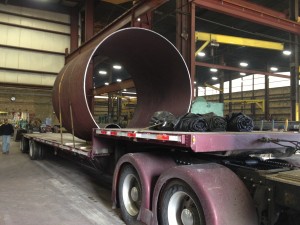But they are not pointless. There are several ways to produce cylinders from metal plate. One of the most common ways is to use a plate roll. Whether the machine has two, three or four rollers, it is usually the case that a certain amount of straight tangent is left on each end after the rolling process. And this straight tangent creates a point where the ends meet.
 Customers prefer truly round cylinders with no points or flats at the seam. There are several methods to avoid these flat spots. One way is to prebend the ends with a press and then roll the rest of the cylinder. Another way is to weld and reroll the cylinders to eliminate any flat spots. In some cases, thermal expansion, due to the heat input from welding, causes the plate to move inward at the seam thereby creating another out-of-round section.
Customers prefer truly round cylinders with no points or flats at the seam. There are several methods to avoid these flat spots. One way is to prebend the ends with a press and then roll the rest of the cylinder. Another way is to weld and reroll the cylinders to eliminate any flat spots. In some cases, thermal expansion, due to the heat input from welding, causes the plate to move inward at the seam thereby creating another out-of-round section.
Another way to make steel cylinders is on a press brake. With this method a radiused punch and a radiused die incrementally form the cylinder as material is fed into the machine.
Below are some pictures of rolled and welded cylinders. The first is made of one-inch thick steel plate rolled to a 114 inch inside diameter 10ft long. The longitudinal weld was done with the submerged arc welding process. The heat of the weld not unexpectedly caused the seam to bend in. Subsequent rerolling restored the uniform curvature desired.


The cylinders in the picture below are made from 5/8 inch x 5 inch Hastelloy bar rolled to a 12.465 inch inside diameter with the ends beveled but not welded. In this case the customer prefers to do the welding. Again, the welding causes the cylinder to go a little out-of-round so the welded cylinders are sent back for rerolling.

With skilled operators, the proper machinery, and the right methods, tight tolerance cylinders can be made to meet stringent standards. [maxbutton id=”3″]







